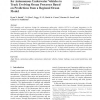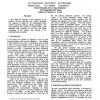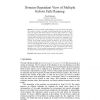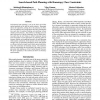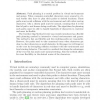161
Voted
Publication
Partially observable Markov decision processes (POMDPs) have been
successfully applied to various robot motion planning tasks under uncertainty.
However, most existing POMDP algo...
132
click to vote
IJRR
2010
14 years 11 months ago
2010
Path planning and trajectory design for autonomous underwater vehicles (AUVs) is of great importance to the oceanographic research community because automated data collection is b...
113
Voted
IJCAI
1989
15 years 1 months ago
1989
In this paper we describe a new approach to the problem of path planning with moving obstacles. Our approach is based on the maneuvering board method commonly used for nautical na...
130
Voted
IJCAI
1997
15 years 1 months ago
1997
In the dynamical systems approach to robot path planning both sensed and remembered information contribute to shape a nonlinear vector eld that governs the behavior of an autonomo...
106
click to vote
FLAIRS
1998
15 years 1 months ago
1998
Path planning for an autonomousvehicle can occur at twodifferent times. First, path planning might occur at mission specification time when the vehicle's initial path is dete...
117
Voted
AAAI
2004
15 years 2 months ago
2004
We present a probabilistic method for path planning that considers trajectories constrained by both the environment and an ensemble of restrictions or preferences on preferred mot...
114
click to vote
STAIRS
2008
15 years 2 months ago
2008
We study a problem of path planning for a group of robots in this paper. The problem is stated as a finding of spatial-temporal paths through which the robots can go from their ini...
108
Voted
AAAI
2010
15 years 2 months ago
2010
Goal-directed path planning is one of the basic and widely studied problems in the field of mobile robotics. Homotopy classes of trajectories, arising due to the presence of obsta...
112
click to vote
ESA
2008
Springer
15 years 2 months ago
2008
Springer
Path planning is a central problem in virtual environments and games. When computer-controlled characters move around in virtual worlds they have to plan their paths to desired loc...
162
Voted
CRV
2005
IEEE
15 years 2 months ago
2005
IEEE
In robotic navigation, path planning is aimed at getting the optimum collision-free path between a starting and target locations. The optimality criterion depends on the surroundi...

